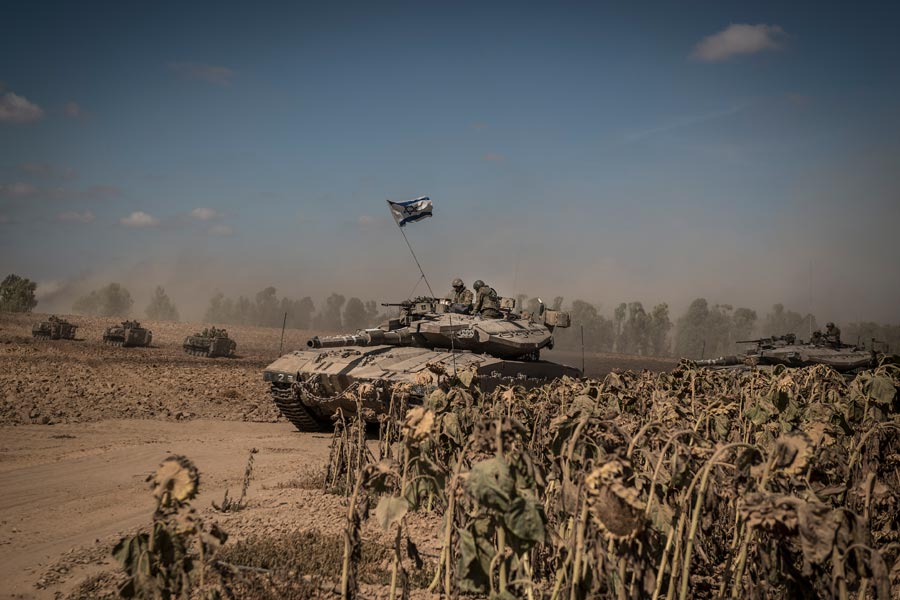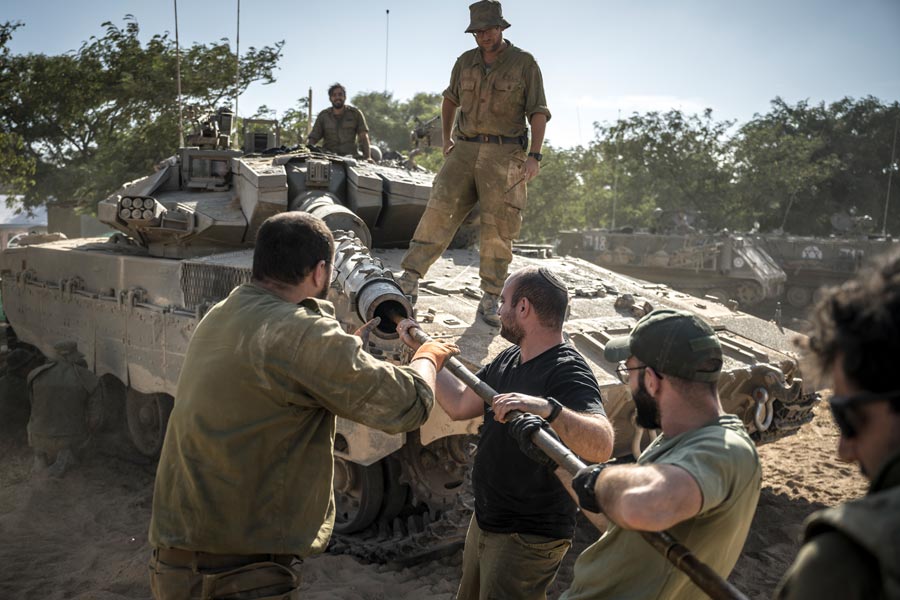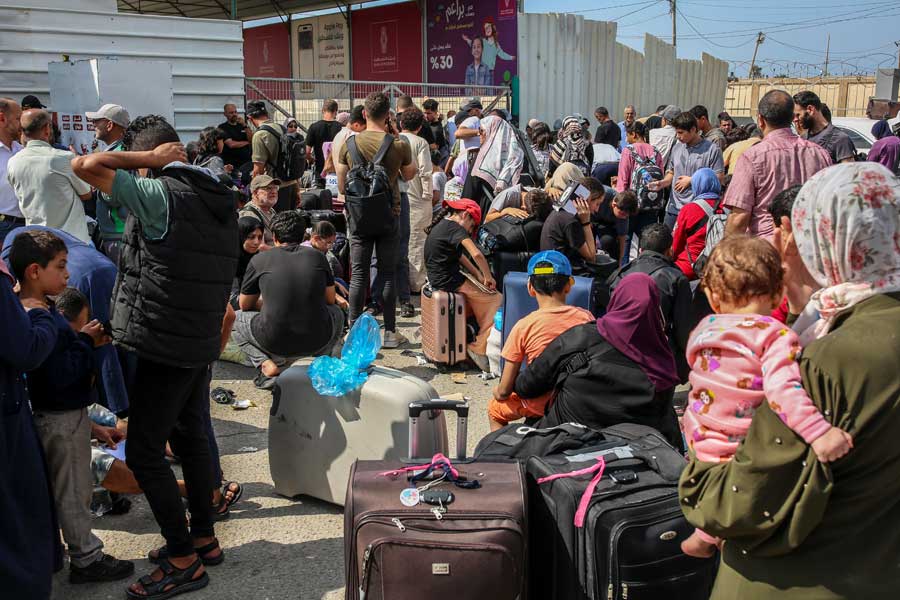
Gaza, the ‘Devil’s Playground’ of urban combat that Israel is preparing to enter
Don't Miss
- India warns Pak counterpart over ceasefire breaches, expresses concern about unprovoked firing
- US Secretary of State Rubio dials Jaishankar, Sharif; urges India, Pakistan to de-escalate tensions
- Deportation of Pakistani Nationals Follows Pahalgam Terror Attack, Sparked by Strained Bilateral Tensions
Hamas has three to five times as many fighters — perhaps 40,000 in all — as the Islamic State had in Mosul. ...on its own, Hamas’ leadership has had years to prepare for battle across Gaza, including in city streets, where the superiority of tanks and precise munitions can be stymied by guerrilla tactics
Heavy fire from rooftops and booby-trapped apartments. Armor-piercing projectiles blowing up troop carriers. Fighters blending in with civilians, launching drone ambushes or surging from tunnels full of enough ammunition, food and water to sustain a long war.
As the Israeli army gathers tanks at the Gaza Strip border for a threatened invasion aimed at crushing Hamas, experts are warning that the country’s troops could face some of the fiercest street-to-street combat since World War II in Gaza City and other densely packed areas.
Urban warfare studies and American officials offer dire comparisons to Iraq: Think of Fallujah, Iraq, in 2004, the most intense battles that U.S. troops had faced since Vietnam; or the nine-month fight to defeat the Islamic State group in Mosul, Iraq, in 2016, which led to 10,000 civilian deaths. Then multiply the destructive toll, possibly exponentially.
Hamas has three to five times as many fighters — perhaps 40,000 in all — as the Islamic State had in Mosul. It can draw reserves from a young, restive population and has international support from countries like Iran. Even on its own, Hamas’ leadership has had years to prepare for battle across Gaza, including in city streets, where the superiority of tanks and precise munitions can be stymied by guerrilla tactics.
“It’s going to be ugly,” said Lt. Col. Thomas Arnold, a U.S. Army strategist who has published studies on urban operations in the Middle East. “Cities are the devil’s playground; they make everything infinitely more difficult.”
Benjamin Netanyahu, Israel’s prime minister, has vowed to “demolish Hamas.” Without sharply defining what that means, he pledged to remove the group from Gaza after its Oct. 7 attack on Israel killed 1,400 people and led to the kidnapping of more than 200 others.
But Gaza, heavily urbanized, with Hamas deeply entrenched, is an especially complex battlefield. Concerned about the challenges ahead, the Biden administration has sent senior military officers to provide advice to the Israelis, based on their own experiences in Iraq, while pressing Israel to delay the invasion to leave more time to negotiate the release of hostages taken by Hamas and to deliver more humanitarian aid. American officials worry that Israel lacks a plan with clear, achievable objectives that would prevent an enormous loss of life among Gaza’s more than 2 million Palestinian civilians.
“I’ve encouraged them to conduct their operations in accordance with the law of war,” Defense Secretary Lloyd Austin said Sunday.
With history as a guide, three factors would most likely shape a ground war in Gaza’s cities: the urban environment, the interaction between fighters and civilians, and political pressures.
The Landscape
The Gaza Strip is about 140 square miles, a narrow band slightly larger in area than Las Vegas, with a cluster of urban population centers. Gaza City, the capital, has around 700,000 people packed into around 20 square miles, with more tall buildings than U.S.-led forces faced in the battle for Mosul, creating a more dangerous three-dimensional front.
Many urban invasions — from the Middle Ages to modernity — have started off with a rapid advance, only to later bog down in districts that favor defenders. Mosul is a prime example; another is last year’s siege of Mariupol. A few thousand Ukrainian soldiers held the city for nearly three months against an advancing Russian force five to eight times as large.
As the Israeli Army gathers tanks at the Gaza border for a threatened invasion aimed at crushing Hamas, experts are warning that the country’s troops could face some of the fiercest street-to-street combat since World War II in Gaza City and other densely packed areas.
(Sergey Ponomarev/The New York Times)
“They leveraged the city’s heavy-clad, industrial buildings and its subterranean network very effectively,” John Spencer, chair of urban warfare studies with the Modern War Institute at the U.S. Military Academy, wrote in a report about the first year of the Ukraine war.
Cities can also be malleable. Israel has destroyed hundreds of Gaza buildings in airstrikes. Hamas, long before its assault on Israel this month, had built hundreds of miles of tunnels under Gaza City that can be used to move among attack positions, hide hostages and protect supplies.
Additional surprises — rocket factories under schools, weapons stored in mosques — are likely to be found if Israel invades.
“Cities can mitigate your technological advantages,” said Arnold, who is completing a doctorate at the University of Virginia. “While Israel is biding its time — setting the conditions, dropping buildings, getting its troops ready — the other side is almost certainly getting ready as well.”
The People
Civilian or combatant? Urban warfare tends to blur the line more often, in deadly ways.
Israel has already been accused of killing thousands of civilians in air attacks, including 1,200 children, according to the Hamas-run Ministry of Health in Gaza. Those figures could not be independently verified, but the risk to civilians clearly remains high.
Even as Israel encourages people in Gaza City to move south to safer areas, many are obeying instructions by Hamas or religious leaders to stay, or saying they cannot afford to go.
It’s a familiar problem. In 2004, the Bush administration gave U.S. Marines only 72 hours to plan an invasion of Fallujah after four American contractors were killed, their mutilated bodies lashed to a bridge. Commanders warned that a revenge-driven operation would endanger civilians and fail, and they pulled back after heavy losses, giving Iraqis six months to flee before a second push.
An estimated 30,000 to 90,000 stayed.
“A lot of the innocent civilians were not allowed to leave,” said Freddie Blish, a retired U.S. Marine lieutenant colonel who was deployed to Fallujah as a combat engineer. “And that’s what’s going to happen with Hamas; they’re going to use them as human shields.”
Israel has emphasized that it does not target civilians. But in urban battles, commanders often take fire from structures housing both fighters and families, forcing a judgment call: Clear the rooms with troops, putting them at risk, or call in a heavier response that might kill civilians.
The tolerance for troop losses tends to decrease as urban warfare drags on.
It took 252 days and 100,000 Iraqi troops, with U.S. air support, to rid Mosul of ISIS. Along with 10,000 civilian deaths, 8,200 Iraqi soldiers suffered casualties, and at least 13,000 buildings were made uninhabitable, according to the United Nations.
Israeli troops, while better trained than the Iraqi army, with years to prepare invasion plans and special engineering units for challenges like tunnels, will face a tougher adversary.
There were 3,000 to 5,000 ISIS fighters in Mosul at the start of the operation, according to initial U.S. military estimates, and a few thousand more came later. Hamas’ military wing, the Al Qassam Brigades, is estimated to number 30,000 to 40,000, not including thousands of militants with other groups like Palestinian Islamic Jihad.
Most ISIS fighters were also from other countries. Hamas fighters grew up in Gaza. Their units are bonded together by location, family, faith and shared frustration with Israel.
“They know the streets. They know the tunnels,” said Blish, the retired lieutenant colonel. “It’s going to be a tough slog.”
Geopolitics
Recent wars have rarely gone as quickly as either side expected: Mosul was supposed to be cleared in three months, not nine; Russia expected a rush to victory in Kyiv, Ukraine. And as the death toll mounts and economies crater, international support often weakens.
Ukraine’s leaders know this better than most, but Israel also has experience with the political and military challenge that comes with extended conflict. Israel’s last ground invasion in Gaza, in 2014, lasted less than three weeks. As Spencer at West Point’s Modern War Institute recently pointed out, Israel “has fought almost every war of its history in a race against time, seeking to achieve its goals before international pressure forces it to stop operations.”
In the current case, Israeli officials have warned that they are expecting several months of fighting, if not years. That would mean a spike in demand for weapons, and added global volatility. American officials are worried about the potential for the war to spread to Lebanon and Iran, along with possible attacks on U.S. troops in Iraq. Those concerns could affect how Washington advises Israel as the conflict evolves.
In past wars, the Israeli public supported military operations as long as they showed progress, with evidence of destroyed weapons stockpiles and other tangible results. Casualties — 66 Israeli soldiers died in the 2014 war — mattered less than “perceptions of the campaign’s success,” according to a Rand Corp. report from 2017.
Now, however, polls show that Israelis have less faith in their government under Netanyahu’s divisive leadership and after his failure to prevent the recent attack. The definition of success is also broader this time and may be harder to achieve in part because Hamas has grown stronger with Iran’s help, vastly increasing its rocket stockpiles and deploying new technology like drones.
Hamas and Israel have already engaged in a contest for sympathy that has spurred angry protests around the world and again made the Middle East a source of international anxiety. How both sides fight with arsenals of weapons in crowded cities will create an even more transformative test of competing narratives and willpower as long as the war lasts.
The New York Times New Service





0 Response to "Gaza, the ‘Devil’s Playground’ of urban combat that Israel is preparing to enter"
Post a Comment
Disclaimer Note:
The views expressed in the articles published here are solely those of the author and do not necessarily reflect the official policy, position, or perspective of Kalimpong News or KalimNews. Kalimpong News and KalimNews disclaim all liability for the published or posted articles, news, and information and assume no responsibility for the accuracy or validity of the content.
Kalimpong News is a non-profit online news platform managed by KalimNews and operated under the Kalimpong Press Club.
Comment Policy:
We encourage respectful and constructive discussions. Please ensure decency while commenting and register with your email ID to participate.
Note: only a member of this blog may post a comment.